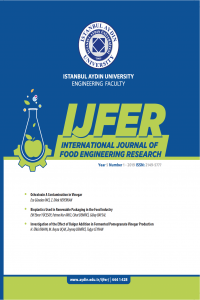DETERMINATION OF THE PRESENCE OF LIVING MICROORGANISMS IN KEFIR GRAIN
DETERMINATION OF THE PRESENCE OF LIVING MICROORGANISMS IN KEFIR GRAIN
Kefir, defined as fermented milk product, is a drink that lactic acid bacteria and yeasts formed together with kefir grain obtained by adding milk and waiting at room temperature for one day. Kefir is being investigated with increasing interest in recent years as it contains micro-organisms useful for health. Although kefir is produced on an industrial scale, consumers have traditionally been producing kefir in homes. This study aimed to determine the presence of living lactic acid bacteria and yeast in kefir grain. Man Rogosa and Sharp (MRS) media were used for isolation and counting of lactic acid bacteria and Yeast extract Glucose Chloramphenicol agar (YGC) was used for yeasts. Kefir grain was found to contain 5x104 CFU/g of living lactic acid bacteria and yeast.
Keywords:
Probiotic, , Lactobacillus, , Yeast, Saccharomyces, benefits , Health,
___
- [1] TGK, (2009). Türk Gıda Kodeksi, Fermente Süt Ürünleri Tebliği, Madde 4. Tarım ve Köy İşleri Bakanlğı, Tebliğ No:2009/25)
- [2] TGK, (2017). Türk Gıda Kodeksi, Fermente Süt Ürünleri Tebliği, Madde 4. Tarım ve Köy İşleri Bakanlğı, Tebliğ No:Taslak/2017.
- [3] Altay, F., Karbancıoglu-Güler, F., Daskaya, C. & Heperkan, D. (2013). A review on traditional Turkish fermented non-alcoholic beverages: Microbiota, fermentation process and quality characteristics. International Journal of Food Microbiology. 167: 44–56.
- [4] Sabir, F., Beyatli, Y., Cokmus, C. & Onal-Darilmaz, D., (2010). Assessment of potential probiotic properties of Lactobacillus spp., Lactococcus spp., and Pediococcus spp. Strains isolated from kefir. Journal of Food Science. 75: 568-573.
- [5] Kesmen, Z & Kacmaz, N. (2011). Determination of lactic microflora of kefir grains and kefir beverage by using culture‐dependent and cultureindependent methods. Food Science. 76 (5): M276-M283
- [6] Leroy, F. & De Vuyst, L. (2004). Lactic acid bacteria as functional starter cultures for the food fermentation industry. Trends in Food Science and Technology. 15: 67-78.
- [7] Simova, E., Beshkova, D., Angelov, A., Hristozova, Ts, Frengova, G. & Spasov, Z., (2002). Lactic acid bacteria and yeasts in kefir grains and kefir made from them. Journal of Industrial Microbiology and Biotechnology. 28: 1-6.
- [8] Powell, J. E., Witthuhn, R. C., Todorov, S. D., & Dicks, L. M. T. (2007). Characterization of bacteriocin ST8KF produced by a kefir isolate Lactobacillus plantarum ST8KF. International Dairy Journal, 17(3), 190-198.
- [9] Wang, J., Zhao, X., Tian, X. Z., He, C., Yang, Y. & Yang, Z. (2015). isolation and characterization of exopolysaccharide-producing Lactobacillus plantarum SKT109 from Tibet kefir. Polish Journal of Food and Nutritional Sciences. 65: 269-279.
- [10] Witthuhn, R. C., Schoeman, T., & Britz, T. J. (2005). Characterisation of the microbial population at different stages of kefir production and kefir grain mass cultivation. International Dairy Journal, 15(4), 383-389.
- [11] Magalhaes, K.T., Pereira, G.V.M., Campos, C.R., Dragone, G. & Schwan, R.F. (2011). Brazilian kefir: structure, microbial communities and chemical composition. Brazilian Journal of Microbiology. 42: 693-702.
- [12] Wang, S., Chen, K., Lo, Y., Chiang, M., Chen, H. & Liu, J. (2012). Investigation of microorganisms involved in biosynthesis of the kefir grain. Food Microbiology. 32: 274-285.
- [13] Renner, E. & Renz, S. (1986). Nahrewettabellen fur milch und milchprodukte. Verlag B. Renner, Köhler K. G. Gieben, Germany.
- [14] Alpkent Z. & Küçükçetin A. (2003). Farklı sıcaklıklarda muhafaza edilen kefirlerin duyusal, fiziksel, kimyasal ve mikrobiyolojik özelliklerinde meydana gelen değişmeler. VI. Süt ve Süt Ürünleri Sempozyumu, Tekirdağ, Türkiye, 22-23 Mayıs, p.363-373
- [15] Karagözlü C. (2003). Kefir-probiotic fermented milk product, 50th Anniversary of The University of Food Teknology HIFFI 15-17 Oct. Collection of Scientific Works of The HIFFI Plovdiv, Bulgaria. 50: 404-409.
- [16] Chen H. C., Wang S. Y. & Chen M. J. (2008). Microbiological study of lactic acid bacteria in kefir grains by culture-dependent and cultureindependent methods. Food Microbiology. 25: 492–501.
- ISSN: 2149-5777
- Başlangıç: 2015
- Yayıncı: İstanbul Aydın Üniversitesi
